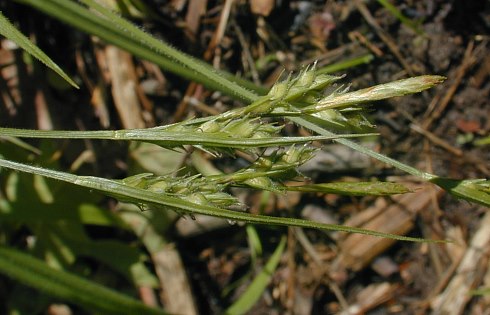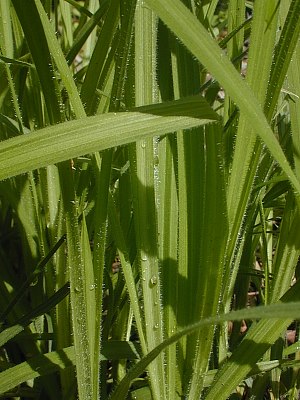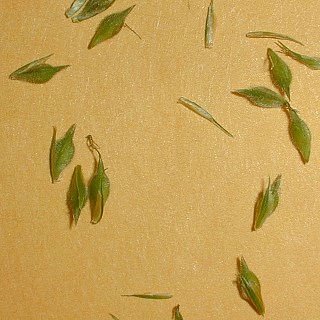Description: This perennial sedge is usually tufted at the base with both vegetative and fertile shoots; each fertile shoot sends up a single unbranched culm about 1¼–2¼' long. The culms are dull green, pubescent, 3-angled, and stiff; they often lean over after their florets bloom. The leaves are confined primarily to the lower third of each culm; they are ascending to widely spreading. The leaf blades are up to 10" long and 8 mm. across, although they are often small than this. The blades are dull green, pubescent, and rather soft and floppy. The leaf sheaths are mostly dull green and pubescent, although their inner sides are membranous. The membranous mouth of each sheath is often fragmented.

Each culm
terminates in an inflorescence consisting of 2-3 pistillate spiklets, a
single terminal staminate spikelet, and their bracts. The typical
inflorescence is about 5-6" in length, although this varies
significantly. Each pistillate spikelet is 8-16 mm. (1/3–2/3") in
length, consisting of about 10-15 florets and their perigynia. The
narrow staminate spikelet is about ½–¾" long; after shedding its
pollen, it soon turns light brown. These spikelets are sessile, or they
have short stiff pedicels up to ¾" long. At the base of each pistillate
spikelet, there is a narrow leafy bract up to 3½" long. These bracts
become smaller as they ascend the inflorescence, and the smaller ones
often break off. The staminate spikelet may have a bract as well, but
it is always scale-like and insignificant. The perigynia are 4.0–5.0
mm. long, broadly ellipsoid, 3-angled, and pubescent. Immature
perigynia are medium green along their edges, otherwise they are pale
green. Each perigynium
is wedge-shaped and pointed at the bottom, while at the apex there is a
short narrow beak. The pistillate scales are about 4.0 mm. long and
usually a little shorter than the perigynia. Each pistillate scale is
obovate with a long narrow tip, and mostly membranous, except for a
narrow green vein in the middle. The blooming period occurs during mid-
to late spring, while the achenes ripen during early to mid-summer
before they are dispersed. The root system is fibrous and rhizomatous.
Cultivation:
The preference is partial sun to light shade, mesic to dry conditions,
and soil containing loam, clay-loam, or some rocky material. This sedge
has above average tolerance of dry conditions. In bright sunlight, the
foliage may become yellowish green.

Range &
Habitat:
The native Hairy Sedge is occasional to locally common throughout
Illinois (see Distribution
Map). Habitats include upland deciduous woodlands, upland oak
savannas, thinly wooded bluffs and slopes, woodland openings, and areas
adjacent to woodland paths. Sometimes the coniferous tree, Juniperus
virginiana (Eastern Red Cedar), is found in the same area as
this sedge.
Faunal Associations:
Many kinds of insects feed on the foliage of Carex spp.
(Sedges). These include the caterpillars of the woodland butterflies Satyrodes
eurydice (Eyed Brown) and Satyrodes appalachia
(Appalachian Brown). The seeds of woodland sedges are eaten by some
upland gamebirds, including the Wild Turkey, Bobwhite, and the chicks
of Ruffed Grouse. White-Tailed Deer, which are common in wooded areas,
prefer to feed on other plants than sedges.
Photographic Location:
A disturbed upland area of Busey Woods in Urbana, Illinois.

Comments: This is the most pubescent sedge in Illinois, which makes it fairly easy to identify. Not only the blades and sheaths, but also the culms and perigynia of this sedge are conspicuously pubescent. Hairy Sedge is typically found in upland wooded areas, especially where the shade of canopy trees is not too dense. Two other sedges with hairy leaves and pubescent perigynia are Carex pellita (Woolly Sedge) and Carex hirta (European Hairy Sedge). These latter two species often produce more than one staminate spikelet per inflorescence, and their pistillate spikelets tend to be longer and more densely packed with perigynia. The perigynia of Woolly Sedge are shorter (less than 4 mm.) than those of Hairy Sedge, while the perigynia of European Hairy Sedge are longer (more than 5 mm.).